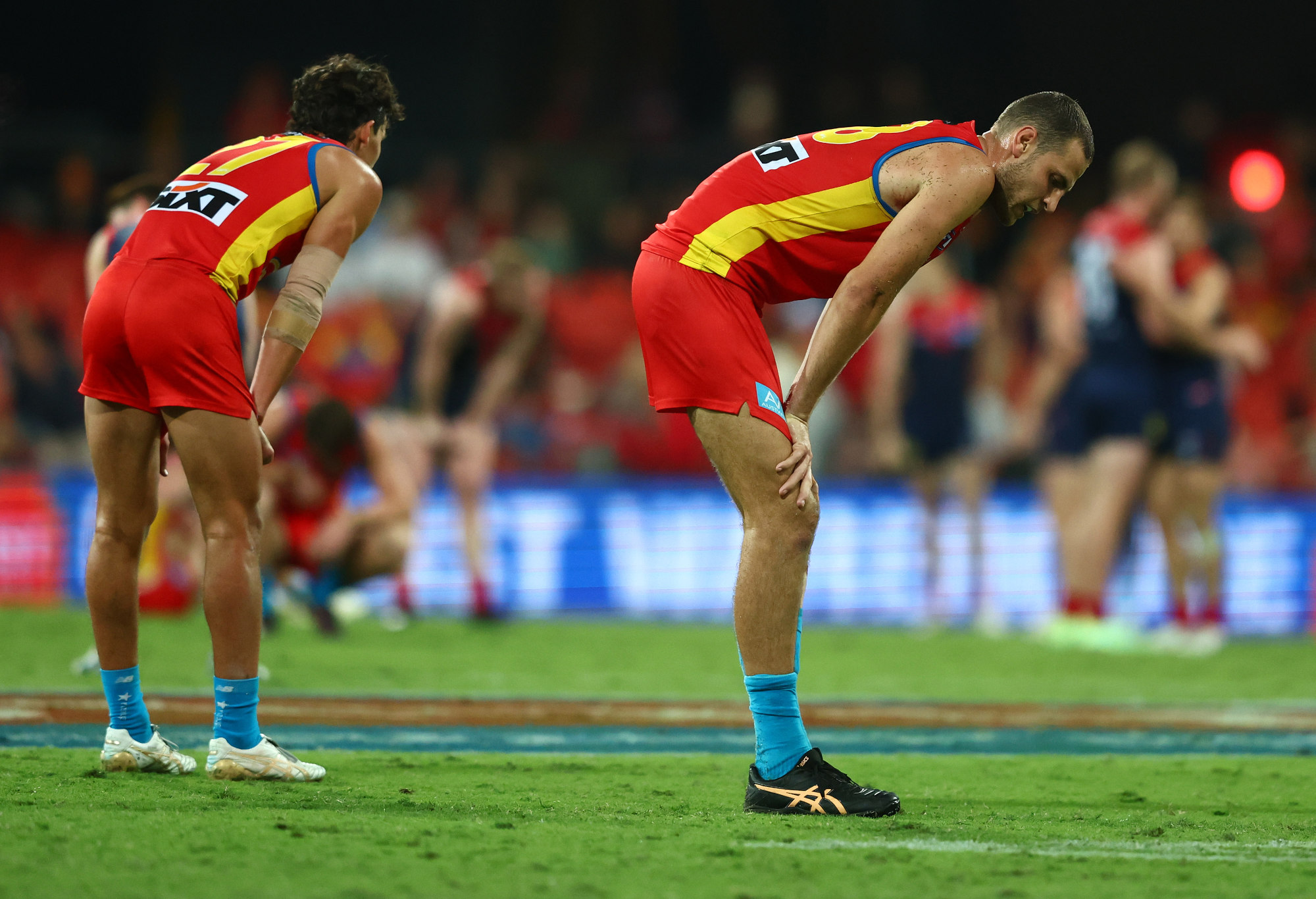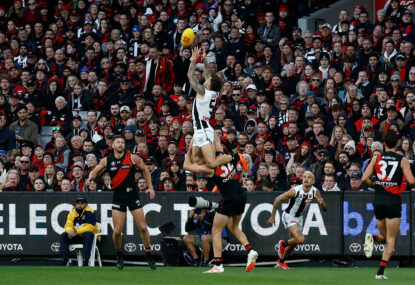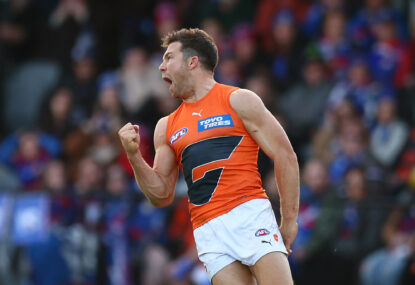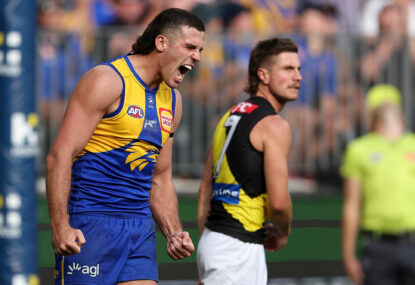No one at Gold Coast should be satisfied with honourable losses anymore.
Match upon match, month upon month, year upon year since their ill-fated entry into the AFL in 2011, the Suns have done more losing than anyone else. They’ve made an art form of the embarrassing capitulation, been thrashed more times than you can count, and occasionally pockmarked it with the sort of exceptional performance that hints that maybe, this time, things will be different.
Internally, the Suns have to be shattered with their latest entry, a five-point loss to Melboune in, if not the best match of 2023 to date, then certainly the toughest. But from a neutral perspective, it’s hard to not fall into the trap of thinking a magnificent performance, regardless of the result, might just be the making of Stuart Dew’s men.
At the very least, it was a coming of age for Gold Coast as a team. Yes, their brightest stars have played better, done more, but they’ve never before gelled as a collective against a team as fearsome as Melbourne. Particularly in the midfield, the Suns didn’t just take the Dees head on – they gave them a hiding as total as anything they’ve copped for years.
Had two seemingly obvious free kicks gone their way in goal-scoring positions late in the game, had a controversial off-the-ball free kick not been plucked to gift Max Gawn a crucial goal, had Darcy Macpherson not butchered a simple set shot in the last minute that every player at the highest level, knackered or not, has no business missing, this could have been the Suns’ most famous win ever.
Instead, all they’re left with is the bitter taste of defeat, a taste I’m sure they’re accustomed to by now; but maybe, just maybe, the Suns now have the talent and the will to say no more.
It’s tough to beat the Demons. Yes, their backline has been decidedly more penetrable this year than in their 2021 pomp, but theirs remains an awesome, multi-faceted midfield led by Clayton Oliver and Christian Petracca, with a ruck combination in Max Gawn and Brodie Grundy looking more in sync by the week. In attack, too, what was once a weakness is now a strength, with the Dees neck in neck with Geelong as the highest-scoring team in the game and capable of mustering 25 scores on Saturday evening, many of their misses eminently kickable.
To beat them, as only Brisbane and Essendon have done this year, you basically have two options: you can either massacre them at stoppages and score heavily from them, or you can strangle their ball movement coming out of defence, isolate their key defenders in one-on-one contests and ensure what supply their forwards get is rushed and unclean.
The Suns went for the former option – naturally. This is a team that, at the very least, knows what it is: a contested ball beast. They headed into Round 8 ranked fifth for total contested possessions this year, but way down in 16th for uncontested ball: it’s win it hard or not at all for them.
Gold Coast don’t really do wingmen in the way most other teams do these days: where Ed Langdon and Lachie Hunter basically don’t leave the boundary line for the Demons, the Suns stack numbers around the contest and use their nominal starting wingers, one of whom is usually Brandon Ellis, behind the ball. It means that, unless you win the centre bounce and handsomely, you’re going to have an almighty fight to get any free ball.
The Demons certainly weren’t winning the centre bounce – by match’s end, the Suns led the stat 14-12, and that doesn’t really do justice to their dominance. Perhaps only once was Petracca allowed to exit stoppages with his usual speed and power – of his three centre clearances, just one led to an inside 50, and that was in a 15-minute patch in the first quarter that basically ensured the Suns would be playing catchup football for the rest of the evening.
Standing opposite Petracca at countless stoppages was Matt Rowell. He has had and will have more impressive figures than his 18 disposals and six tackles on Saturday night; but he still found time to have a game-high 11 clearances and 13 contested possessions. He is basically the Suns in a nutshell: ferocious at the contest, hard-nosed, strong and powerful, but no trace of easy footy to play tempo or pad his stats. He lives for stoppages, and almost ceases to exist once they disperse.
But together with David Swallow, Rowell not only bossed Petracca directly a number of times in the first and second quarters with powerful breakaways, strong tackles and a series of shrugs to find space on the superstar No.5, but ensured Clayton Oliver was rarely if ever given a free run at the ball.

Jarrod Witts and Wil Powell of the Suns. (Photo by Chris Hyde/Getty Images)
Once thought impossible to stop, many teams are now putting huge amounts of effort into stopping Oliver dictating terms at the coalface; the numbers he can rack up are just so obscene that to even contain him, and force him to try something different, is a huge win.
With six clearances to three quarter time, just one from the centre, Oliver was still having an impact, but far from his usual dominance. His final term, then, was the measure of the man: nine disposals, just two of them contested, but four marks as he pushed his body to the limit to get involved in midfield possession chains again and again to help the Dees transition from defence to attack.
That’s without even mentioning Noah Anderson, the standout best player on the ground after a match that rivals his heroics against Richmond last year for the finest of his young career.
Remember that patch of games after the COVID resumption in 2020 where Rowell just did as he pleased? That’s basically what Anderson is doing now. It’s remarkable to think that, had the Suns not been granted an extra top pick in 2019 by virtue of sucking really, really hard, he’d be in Melbourne colours right now. (An interesting thought: do the Dees win it all in 2021 with Noah Anderson instead of Luke Jackson?)
Now that he’s fixed up his once-errant ball use – he went at 81 per cent efficiency from his 37 disposals on Saturday evening, and with 476 metres gained and seven score involvements it wasn’t as if he wasn’t taking risks – there’s almost no weakness in his game. For the guy who was supposed to be the outside-runnning Robin to Rowell’s stoppage-beast Batman when he was drafted, Anderson is extraordinarily tough over the ball.
His 17 contested possessions were far and away the most on the ground, while only Rowell had more than his 10 clearances. Five of them game from the centre, one fewer than Oliver, Petracca and Viney combined: and he doesn’t mess around with them, either, repeatedly driving the Suns deep into attack.
Capping off his game with a fine goal in the last quarter, just minutes after looking utterly spent, it takes some doing to be the best midfielder on a ground also featuring Oliver and Petracca. That’s how good Anderson was. That’s how good Anderson is.
A combination of all those factors left the Dees in a rare position of contested ball vulnerability; their 51 contested possessions to half time was their lowest in a first half since 2020, while the Suns finished with a 149-122 advantage – the Dees’ equal-worst differential under Simon Goodwin. More than that, to three quarter time, the Suns led the Demons, the most potent stoppage scoring team of the last three years, by 25 points from scores from that source.
With scores level at that point, it was only the Demons’ proficiency at capitalising on turnovers with speedy ball movement into an open 50 that was keeping them in the game, never mind ahead.
That has always been the weakness with the new-age Suns: they will kill you for the hard ball, but have never allowed themselves to cut opposition teams to ribbons on the outside. Too often, they give up repeat inside-50 entries to opponents because a crucial rebounding kick is missed; too often, that last pass inside their own attacking 50 goes to ground or sails over a head or is dropped by a leading forward.
The difference, in the end, was the first 15 minutes, with the Dees going three goals to zero ahead and never truly getting headed from there: in that time, they had five kicks inside 50 and found a red and blue jumper with four of them. The Suns, in contrast, had two from six.
It’s an issue they’ve tried to rectify with recasting Jack Lukosius as a quasi-centre-half forward, free to roam as he likes so long as he’s always within kicking range of the arc. Regarded as one of the game’s best kicks, he’s entrusted to bite off passes risky enough that you can always count on his disposal efficiency to be a bit misleading; but with just eight of his 15 disposals finding a target, plus three misses in front of goal, him rising from inconsistent to elite is surely holding the Suns back more than anything, and anyone, else.
Defensively, the Suns’ system remains a problem, one enhanced by the fact their midfield, for all its strength at the coalface, can get shown up running defensively. Especially without Touk Miller.
The Demons sensed an opportunity to make the most of this: frequently in the first half, you could see Petracca or Viney sprinting forward from a contest when the Dees had possession, some 20 or even 30 metres ahead of the Suns midfielders who had manned them at the centre bounce.
It’s a high-risk strategy, and one that left them vulnerable to turnovers at the source before those kicks using them could get away; but the Dees back their own structure behind the ball, and their teammates with it, to use that to their advantage.
By half time, the Suns’ contested ball dominance was enough that it was no longer safe for the Demons to be so gung-ho, and they reverted to more traditional means of scoring: forcing midfield turnovers. It’s why, despite losing the clearance count and getting smashed for the hard ball, the Dees ended with a 61-45 inside 50 advantage: repeat entries kept their forwards in the game, and kept the ball within range of the goals far more than for the Suns.
Pressure is one element: the Dees had 11 tackles inside attacking 50 to the Suns’ 7 for the match, as part of a 66-44 tackle advantage. Yes, the Suns had more of the ball, but the Demons made them sweat: this year, they’ve been the number one side at generating pressure inside 50, with an average rating of 174 across the first seven rounds.
Sure, the Suns got plenty of the ball in their back 50, racking up 94 marks to 66 for the match – 11 each to interceptors Wil Powell and Charlie Ballard, and seven to another defender in Darcy Macpherson.
But this is where their midfield, and their system, encounters problems: invariably, the Suns are forced into a long bomb down the line, where they rarely if ever could compete against the Demons.
If the ball came to ground – and unless Levi Casboult clunked a contested grab, that’s where it was going – the Dees could swoop, which they did with six goals from their first 13 forward half possession chains.
The most glaring example was Tom Sparrow’s goal in the third quarter: as good as the finish was, it’s an ugly look that three Demons – Sparrow, Jack Viney and Max Gawn – were all goal side of any Suns midfielder in such an attacking position.
The Suns had 14 of those intercepts when the Dees found their 13th, but just one goal from them. The reason? Their ball use remained problematic, not helped by the Dees’ pressure, while Melbourne’s defensive set-up was far sounder. Setting up further out from goal than they have this year, hence the lack of Suns’ inside 50s, they put up a wall and made it tough for the Suns to get past.
There’s so much for the Suns to learn from the way the Demons were able to repel them, as close as it was in the end. This year, Melbourne have learned there’s more to life than contested possessions. Having lost the count a combined eight times across 49 matches in 2021-22, they’re 3-5 this season.
They’ve had wins over the Western Bulldogs, Richmond and now the Suns having had fewer contested possessions – unlike the Suns, they don’t need to dominate that count to win. They have more of an outside game now, no doubt helped by the recruiting of Hunter as a hard-running wingman who thrives in that environment.
It’s contested ball or bust for the Suns – but when they play as well as they did on Saturday against the competition’s best midfield, it’ll be enough to win more often than not. This team is closer than the football world thinks – perhaps even closer than they themselves think.
Not for the first time in recent years, the Suns are at a flashpoint. This epic, magnificent, unsuccessful performance could be followed up by yet more inconsistency, yet more mediocrity, and it will be remembered as just another almost for this long-suffering football club.
Or it could be what their famous win over Collingwood with no bench in 2014, or Rowell’s emergence onto the scene for three straight wins in 2020, or their win after the siren against Richmond was last year, SHOULD have been: the dawn of Gold Coast as a club that can match it with anyone, anytime, anywhere. A club to be respected. A club that will no longer go quietly into the night.
All the pieces are there. It’s time for the Suns to decide what they want to be.



































































































